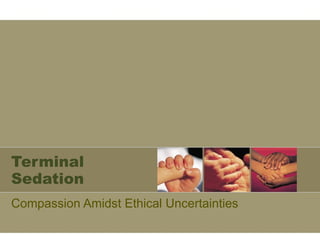
Terminal Sedation: Relief Amidst Ethical Complexity
- 1. Terminal Sedation Compassion Amidst Ethical Uncertainties
- 2. Your Instructor Greg Burns, RN, ELNEC Phone: (866) 441-4277 or (207) 773-2947 Fax: (207) 773-3617 Email: gary@jasonprogram.org Web: www.jasonprogram.org
- 4. General Concept 1992 -- When all else fails: 17 year old girl with relapsed Ewing's sarcoma, multiple bony metastases, pelvic mass compressing her spine and causing bilateral leg paralysis, constant severe bone, abdominal, and pelvic pain. Cannot swallow. Morphine drip at 1000 mg/hour and no pain relief or sedation. Fentanyl and Dilaudid were ineffective. When this happened, ketamine and Precedex were unavailable. The anesthesia team could not place a catheter due to the large tumor burden. What can be done?
- 7. So Let’s See What The Ethicists Have to Say Since Then
- 9. Preference for the different terms with medical background without medical background “ Sedation at the end of life” 38% 36% “ Palliative sedation” 53% 41% “ Terminal sedation” 32% 46% Conclusion
- 10. It’s a close call… and often the answer changes
- 14. Attitudes: Physical vs. Mental/Emotional Suffering Moral evaluation of different scenarios M=medical professional ØM = Non-medical background Dying patient Acceptable Not acceptable Don't know M øM M øM M øM Physical suffering Only sedation 98 97 1 1 1 1 Sedation + withdrawal of nutrition 86 89 12 8 3 3 Only withdrawal of nutrition 92 95 6 5 3 0 Mental suffering Only sedation 61 52 23 39 16 9 Sedation + withdrawal of nutrition 55 44 29 46 16 10 Only withdrawal of nutrition 68 63 21 22 11 14
- 15. Attitudes: Physical vs. Mental/Emotional Suffering Moral evaluation of different scenarios M=medical professional ØM = Non-medical background Patient with unfavourable prognosis Acceptable Not acceptable Don't know M øM M øM M øM Physical suffering Only sedation 74 66 17 23 9 11 Sedation + withdrawal of nutrition 63 56 28 30 9 14 Only withdrawal of nutrition 78 71 17 22 5 7 Mental suffering Only sedation 37 36 43 47 20 18 Sedation + withdrawal of nutrition 32 27 48 52 20 21 Only withdrawal of nutrition 52 50 34 39 14 12
- 18. Careful – People have opinions, and end-of-life issues generate powerful opinions. Could anyone be thinking that you want to euthanize the patient? Communicate well!
- 24. Sedation in palliative care – a critical analysis of 7 years experience BMC Palliative Care 2003, 2: 2 - No difference was found in the duration of stay in our unit until death between those patients who died with, and those who died without sedation. % patients receiving palliative sedation
- 35. Now you can do the right thing… Even if it is sad R.M.A
- 36. Thank you for listening If you even need help, you can easily find us: The Jason Program 65 Washington Avenue Portland, ME 04101 Phone: (207) 773-2947 or (866) 441-4277 Fax: (207) 773-3617 Email: [email_address] or [email_address] Web: www.jasonprogram.org ************************************************************************
Notas do Editor
- 19 The first medical publication to address the need for using sedation as a means of comfort while also addressing the principle of double effect. The person prescribing sedation must have comfort care as the only intended effect.
- 20 Includes both physical and non-physical suffering
- Your choice !
- The respondents had a professional background in the fields of medicine, nursing care, philosophy, theology, law and/or others. Which term do we used to describe”terminal sedation”.
- No surprise
- This is a European study of both professional and nonprofessional people. They looked at the use of sedation to relieve distress in patients with physical and mental suffering and asked those individuals to determine if different scenarios were acceptable or not acceptable to them.
- This is the same thing, except the patient had unfavorable prognoses but were not immediately dying.
- Peaceful to the member with the sticking points are.
- ICU Specific – same ideas
